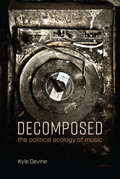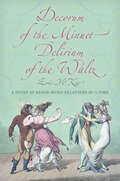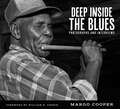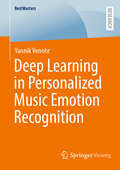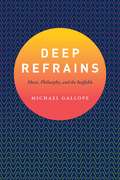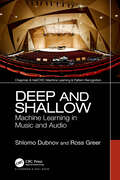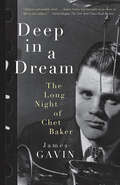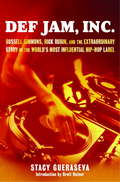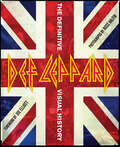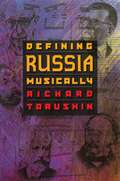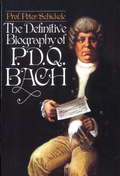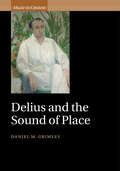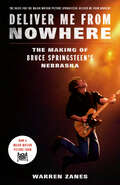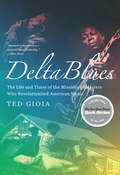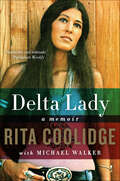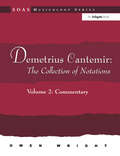- Table View
- List View
Decomposed: The Political Ecology of Music (The\mit Press Ser.)
by Kyle DevineThe hidden material histories of music.Music is seen as the most immaterial of the arts, and recorded music as a progress of dematerialization—an evolution from physical discs to invisible digits. In Decomposed, Kyle Devine offers another perspective. He shows that recorded music has always been a significant exploiter of both natural and human resources, and that its reliance on these resources is more problematic today than ever before. Devine uncovers the hidden history of recorded music—what recordings are made of and what happens to them when they are disposed of. Devine's story focuses on three forms of materiality. Before 1950, 78 rpm records were made of shellac, a bug-based resin. Between 1950 and 2000, formats such as LPs, cassettes, and CDs were all made of petroleum-based plastic. Today, recordings exist as data-based audio files. Devine describes the people who harvest and process these materials, from women and children in the Global South to scientists and industrialists in the Global North. He reminds us that vinyl records are oil products, and that the so-called vinyl revival is part of petrocapitalism. The supposed immateriality of music as data is belied by the energy required to power the internet and the devices required to access music online. We tend to think of the recordings we buy as finished products. Devine offers an essential backstory. He reveals how a range of apparently peripheral people and processes are actually central to what music is, how it works, and why it matters.
Decomposition
by Andrew DurkinDecomposition is a bracing, revisionary, and provocative inquiry into music--from Beethoven to Duke Ellington, from Conlon Nancarrow to Evelyn Glennie--as a personal and cultural experience: how it is composed, how it is idiosyncratically perceived by critics and reviewers, and why we listen to it the way we do. Andrew Durkin, best known as the leader of the West Coast-based Industrial Jazz Group, is singular for his insistence on asking tough questions about the complexity of our presumptions about music and about listening, especially in the digital age. In this winning and lucid study he explodes the age-old concept of musical composition as the work of individual genius, arguing instead that in both its composition and reception music is fundamentally a collaborative enterprise that comes into being only through mediation. Drawing on a rich variety of examples--Big Jay McNeely's "Deacon's Hop," Biz Markie's "Alone Again," George Antheil's Ballet Mécanique, Frank Zappa's "While You Were Art," and Pauline Oliveros's "Tuning Meditation," to name only a few--Durkin makes clear that our appreciation of any piece of music is always informed by neuroscientific, psychological, technological, and cultural factors. How we listen to music, he maintains, might have as much power to change it as music might have to change how we listen.From the Hardcover edition.
Decorum of the Minuet, Delirium of the Waltz: A Study of Dance-Music Relations in 3/4 Time
by Eric McKeeAn investigation of dance-music relations in two out of the three most influential social dances of the eighteenth and nineteenth centuries.Much music was written for the two most important dances of the eighteenth and nineteenth centuries, the minuet and the waltz. In Decorum of the Minuet, Delirium of the Waltz, Eric McKee argues that to better understand the musical structures and expressive meanings of this dance music, one must be aware of the social contexts and bodily rhythms of the social dances upon which it is based. McKee approaches dance music as a component of a multimedia art form that involves the interaction of physical motion, music, architecture, and dress. Moreover, the activity of attending a ball involves a dynamic network of modalities—sight, sound, bodily awareness, touch, and smell, which can be experienced from the perspectives of a dancer, a spectator, or a musician. McKee considers dance music within a larger system of signifiers and points-of-view that opens new avenues of interpretation.“McKee’s book . . . fulfils its aim: that of presenting dance-music relations in two out of three of the most popular ballroom dances in several centuries. To my knowledge, there is no other English publication on such intersection of topics—thus it deserves a place in the libraries of music and dance departments.” —Gediminas Karoblis, Dance Research“I think this is an important book for musicians and dance academics alike, since McKee proposes that to understand the musical structures of the minuet and waltz, “it is helpful to be aware of the bodily rhythms of the dance upon which they are based and the social contexts in which they were performed”. . . . McKee’s holistic approach illuminates the total experiences of all the participants. . . . highly informative on the importance of dancing at every level of society, and its varying social functions, during the eighteenth and nineteenth centuries.” —Dance Europe“McKee’s overall orientation is laudable, since functional dance music has largely been ignored by music analysts, and stylized dance music has been treated as if it had minimal connection to the practice of dancing. . . . Despite the amount of close music analysis, McKee’s writing is accessible to a wide range of readers. . . . One hopes that McKee has plans for a future book to follow the mid-century delirium of the waltz to its twentieth-century demise.” —Nineteenth-Century Music Review
Deems Taylor: Selected Writings
by James PegolottiDeems Taylor (1885-1966) was a composer, music critic, author, commentator, translator, and artist. He was the first American composer commissioned to write an opera by New York’s Metropolitan Opera, and composed orchestral and solo works that remain part of the repertoire. He gained fame initially introducing the regular radio broadcasts of the New York Philharmonic in the mid-‘30s; his fame was so great, that animator Walt Disney invited him to be the on-screen host of Fantasia. Taylor wrote for many popular journals, including Vanity Fair and the New Yorker, as well as the daily press, and his work was collecting in many best-selling books. Taylor’s biographer, James Pegolotti, has made a fresh selection of the best of Taylor’s writings on music for this new volume. Divided into parts reflecting a chronological look at Taylor’s entire career, the work exposes the reader to Taylor’s wit and keen intellect. Pegolotti has written brief introductions for each section, placing Taylor’s work in the context of its time.Deems Taylor: Selected Writings brings into full view a forgotten important music reviewer and social commentator of the first half of the twentieth century.
Deep Blues: A Musical and Cultural History of the Mississippi Delta
by Robert PalmerBlues is the cornerstone of American popular music, the bedrock of rock and roll. In this extraordinary musical and social history, Robert Palmer traces the odyssey of the blues from its rural beginnings, to the steamy bars of Chicago’s South Side, to international popularity, recognition, and imitation. Palmer tells the story of the blues through the lives of its greatest practitioners: Robert Johnson, who sang of being pursued by the hounds of hell; Muddy Waters, who electrified Delta blues and gave the music its rock beat; Robert Lockwood and Sonny Boy Williamson, who launched the King Biscuit Time radio show and brought blues to the airwaves; and John Lee Hooker, Ike Turner, B. B. King, and many others.
Deep Inside the Blues: Photographs and Interviews (American Made Music Series)
by Margo CooperDeep Inside the Blues collects thirty-four of Margo Cooper’s interviews with blues artists and is illustrated with over 160 of her photographs, many published here for the first time. For thirty years, Cooper has been documenting the lives of blues musicians, their families and homes, neighborhoods, festivals, and gigs. Her photographic work combines iconic late-career images of many legendary figures including Bo Diddley, Honeyboy Edwards, B. B. King, Pinetop Perkins, and Hubert Sumlin with youthful shots of Cedric Burnside, Shemekia Copeland, and Sharde Thomas, themselves now in their thirties and forties. During this time, the Burnside and Turner families and other Mississippi artists such as T-Model Ford, James “Super Chikan” Johnson, and L. C. Ulmer entered the national and international spotlight, ensuring the powerful connection between authentic Delta, Hill Country, and Piney Woods blues musicians and their audience continues. In 1993, Cooper began photographing in the clubs around New England, then in Chicago, and before long in Mississippi and Helena, Arkansas. On her very first trips to Mississippi in 1997 and 1998, Cooper had the good fortune to photograph Sam Carr, Frank Frost, Bobby Rush, and Otha Turner, among others. “The blues come out of the field,” Ulmer told Cooper. Seeing those fields, as well as the old juke joints, country churches, and people’s homes, inspired her. She began recording interviews with the musicians, sometimes over a period of years, listening and asking questions as their narratives unfolded. Many of the key blues players of the period have already passed, making their stories and Cooper’s photographs of them all the more poignant and valuable.
Deep Learning in Personalized Music Emotion Recognition (BestMasters)
by Yannik VenohrMusic has a unique power to evoke strong emotions in us—bringing us to tears, lifting us into ecstasy or triggering vivid memories. Often described as a universal language, it conveys feelings that transcend words. But are machines, too, able to understand this language and capture emotions conveyed in music? This book delves into the field of Musical Emotion Recognition (MER), aiming to develop a mathematical model to predict the emotional content of music. It explores the fundamentals of this interdisciplinary research area, including the relationship between music and emotions, mathematical representations of music and deep learning algorithms. Two MER models are developed and evaluated: one employing handcrafted audio features with a long short-term memory architecture and the other using embeddings from the pre-trained music understanding model MERT. Results show that MERT embeddings can enhance predictions compared to traditional handcrafted features. Additionally, driven by the subjectivity of musical emotions and the low inter-rater agreement of annotations, this book investigates personalized emotion recognition. The findings suggest that personalized models surpass the limitations of general MER systems and can even outperform a theoretically perfect general MER system.
Deep Refrains: Music, Philosophy, and the Ineffable
by Michael GallopeWe often say that music is ineffable, that it does not refer to anything outside of itself. But if music, in all its sensuous flux, does not mean anything in particular, might it still have a special kind of philosophical significance? In Deep Refrains, Michael Gallope draws together the writings of Arthur Schopenhauer, Friedrich Nietzsche, Ernst Bloch, Theodor Adorno, Vladimir Jankélévitch, Gilles Deleuze, and Félix Guattari in order to revisit the age-old question of music’s ineffability from a modern perspective. For these nineteenth- and twentieth-century European philosophers, music’s ineffability is a complex phenomenon that engenders an intellectually productive sense of perplexity. Through careful examination of their historical contexts and philosophical orientations, close attention to their use of language, and new interpretations of musical compositions that proved influential for their work, Deep Refrains forges the first panoptic view of their writings on music. Gallope concludes that music’s ineffability is neither a conservative phenomenon nor a pious call to silence. Instead, these philosophers ask us to think through the ways in which music’s stunning force might address, in an ethical fashion, intricate philosophical questions specific to the modern world.
Deep and Shallow: Machine Learning in Music and Audio
by Shlomo Dubnov Ross GreerProviding an essential and unique bridge between the theories of signal processing, machine learning, and artificial intelligence (AI) in music, this book provides a holistic overview of foundational ideas in music, from the physical and mathematical properties of sound to symbolic representations. Combining signals and language models in one place, this book explores how sound may be represented and manipulated by computer systems, and how our devices may come to recognize particular sonic patterns as musically meaningful or creative through the lens of information theory. Introducing popular fundamental ideas in AI at a comfortable pace, more complex discussions around implementations and implications in musical creativity are gradually incorporated as the book progresses. Each chapter is accompanied by guided programming activities designed to familiarize readers with practical implications of discussed theory, without the frustrations of free-form coding. Surveying state-of-the art methods in applications of deep neural networks to audio and sound computing, as well as offering a research perspective that suggests future challenges in music and AI research, this book appeals to both students of AI and music, as well as industry professionals in the fields of machine learning, music, and AI.
Deep in a Dream: The Long Night of Chet Baker
by James GavinFrom his emergence in the 1950s as an uncannily beautiful young Oklahoman who became the prince of "cool" jazz seemingly overnight to his violent, drug-related death in Amsterdam in 1988, Chet Baker lived a life that has become an American myth. Drawing on hundreds of interviews and previously untapped sources, this first major biography of one of the most romanticized icons in jazz gives a thrilling account of the trumpeter's dark journey. Author James Gavin delves deeply into Baker's tormented childhood, the origins of his melancholic trumpet playing, and even reveals the long-unsolved riddle of Baker's demise. Baker's otherworldly personal aura struck a note of menace and mystery that catapulted him to fame in the staid 1950s but as time wore on, his romance with drugs became highly publicized. Gavin narrates the harrowing spiral of dependency down which Baker tumbled and illustrates how those who dared to get close were dragged down with him. This is the portrait of a musician whose singular artistry and mystique has never lost the power to enchant and seduce.
Deep in a dream: La larga noche de Chet Baker
by James GavinLa gran biografía de Chet Baker, el legendario trompetista y cantante de jazz. Desde 1950, cuando un atractivo joven de Oklahoma apareció en la Costa Oeste como nuevo príncipe del cool jazz, hasta su violenta muerte en Amsterdam relacionada con las drogas, la vida de Chet Baker lo convirtió en un mito. En esta biografía, que incluye cientos de entrevistas y fuentes inéditas, James Gavin hace un recorrido por la vida del trompetista. La historia de Chet Baker es desmenuzada desde su atormentada y traumática infancia: Gavin explora el nacimiento de esa melancólica forma de tocar la trompeta, su voz frágil, y el aura que lo llevó a la fama. Sexy, angelical, rebelde y querido, Chet Baker se convirtió en el James Dean del jazz. Su misteriosa figura volvió locos a mujeres y hombres. Sin embargo, su verdadero amor, además de la música, fue la droga. La crítica ha dicho...«Arrebatadora y fascinante. Trae de regreso la persona de Baker entre los vivos. El corazón de este libro late muchísimo más fuerte que la inmensa mayoría de las biografías de músicos.»The Boston Globe «Una biografía extraordinaria y monumental.»La Stampa «Una formidable muestra de arte biográfico. No hay una sola página en este libro que no sea adictiva, que no esté viva, que no le exija al lector una reacción, ya sea de horror o admiración.»Greil Marcus, Salon «Un retrato casi insoportablemente realista. James Gavin nos ha puesto al personaje tan cerca como la vida misma.»David Hajdu, New York Times Book Review «Una biografía divulgativa imprescindible.»Tony Gieske, Hollywood Reporter «El retrato más redondo y lúcido del trompetista que ha sido escrito jamás. Esta es la biografía definitiva de Baker.»Christopher Porter, JazzTimes «Completísima, una biografía de lectura compulsiva.»Jack Batten, Toronto Star «Un relato espeluznante. Debería atraer a toda persona interesada en una historia perfectamente narrada.»Greg Delaney, Independent «Una comedia negra repleta de desenfreno, escrita con un ritmo y visión a los que ni siquiera el purista del jazz más esencialista le encontraría un defecto.»Kenneth Wright, Sunday Herald «Un libro nacido del amor artístico y la honestidad intelectual, escrito con la fluidez y el dramatismo de una novela.»Paolo Russo, La Repubblica «Una brillante y oscura biografía de la leyenda blanca del jazz. Baker es un misterio al que James Gavin se asomó atento a las contradicciones.»Diego Fischerman, Página/12
Deeper Blues: The Life, Songs, and Salvation of Cornbread Harris
by Andrea SwenssonThe emotional, epic story of James &“Cornbread&” Harris—a self-proclaimed &“blessed dude&” and one of Minneapolis&’s most influential musicians From the heart of the Minnesota blues comes the story of James &“Cornbread&” Harris Jr., the songwriter, pianist, and consummate bluesman whose seventy years making music helped to shape the Minneapolis Sound. &“I am a blessed dude,&” Cornbread tells Andrea Swensson, taking us along on his musical journey from a first &“gig&” entertaining his fellow soldiers during World War II to his subsequent years playing music for audiences across Minnesota. Following Cornbread&’s extraordinary life story, Deeper Blues is a unique history of Minnesota music that evolves into a heartfelt tale of reconciliation and forgiveness, all to the tune of the legendary musician&’s signature sound. Cornbread&’s career started in the 1950s, when he played with the Augie Garcia Quintet and cowrote their hit &“Hi Ho Silver.&” A tireless entertainer, he has been performing live ever since, influencing an entire generation of musicians credited with putting Minneapolis on the map in the 1980s—including his long-estranged son, Grammy-winning Rock and Roll Hall of Famer James &“Jimmy Jam&” Harris III. Going beyond the music, Deeper Blues turns toward family, atonement, and peace when Cornbread reunites with Jimmy Jam after a five-decade separation and they perform together on stage. Through conversations with Cornbread, Jimmy Jam, and many others, Swensson reveals a story of perseverance and unfailing grace, a firsthand account of making music in the face of racism and segregation, and a hard-won acceptance of the personal sacrifices that are often required when dedicating one&’s life to making music. As the man himself says, &“All of my hardships ended up to be blessings.&” A rich mix of present-day anecdotes and historical vignettes, animated by voices from Cornbread&’s life and the Twin Cities music scene, underscored by the bluesman&’s original lyrics of heartache and hope, and featuring never-before-seen photographs of Cornbread and Jimmy Jam, Deeper Blues tells a singular story—one imprinted on the history, heart, and soul of the Minneapolis Sound.
Def Jam, Inc.: Russell Simmons, Rick Rubin, and the Extraordinary Story of the World's Most Influential Hip-hop Label
by Brett Ratner Stacy GuerasevaIn the early '80s, the music industry wrote off hip-hop as a passing fad. Few could or would have predicted that the improvised raps and raw beats busting out of New York City's urban underclass would one day become a multimillion-dollar business and one of music's most lucrative genres. Among those few were two visionaries: Russell Simmons, a young black man from Hollis, Queens, and Rick Rubin, a Jewish kid from Long Island. Though the two came from different backgrounds, their all-consuming passion for hip-hop brought them together. Soon they would revolutionize the music industry with their groundbreaking label, Def Jam Records.Def Jam, Inc. traces the company's incredible rise from the NYU dorm room of nineteen-year-old Rubin (where LL Cool J was discovered on a demo tape) to the powerhouse it is today; from financial struggles and scandals-including The Beastie Boys's departure from the label and Rubin's and Simmons's eventual parting-to revealing anecdotes about artists like Slick Rick, Public Enemy, Foxy Brown, Jay-Z, and DMX. Stacy Gueraseva, former editor in chief of Russell Simmons's magazine, Oneworld, had access to the biggest players on the scene, and brings you real conversations and a behind-the-scenes look from a decade-and a company-that turned the music world upside down. She takes you back to New York in the '80s, when late-night spots such as Danceteria and Nell's were burning with young, fresh rappers, and Simmons and Rubin had nothing but a hunch that they were on to something huge.Far more than just a biography of the two men who made it happen, Def Jam, Inc. is a journey into the world of rap itself. Both an intriguing business history as well as a gritty narrative, here is the definitive book on Def Jam--a must read for any fan of hip-hop as well as all popular-culture junkies.
Def Leppard: The Definitive Visual History
by Ross Halfin Joe ElliottDef Leppard's unstoppable, anthemic hard rock has earned it sales of more than 65 million albums worldwide and a legion of dedicated fans. This fully authorized visual history of the band follows them from the new wave of British heavy metal to their massive Pyromania and Hysteria albums to the sustained power of their records and tours today. Legendary rock photographer Ross Halfin has been shooting Def Leppard since 1978, and his candid and definitive pictures have helped capture and shape the image of the band. Def Leppard includes more than 450 classic and unseen photographs, along with text from Halfin and stories and commentary by the band members and others.
Defensive Eating with Morrissey: Vegan Recipes from the One You Left Behind
by Joshua Ploeg Automne ZinggPoor Morrissey. He's just so... so... hungry. And meat is murder, so that narrows his options by a lot. Until now, at least! With the arrival of the Defensive Eating with Morrissey cookbook, our dear Moz no longer needs to suffer such terrible hunger, such ruthless indecision, or the emotional impact of a major blood sugar crash at the worst possible moment. These 100+ vegan recipes make enough unbelievably delicious, poetic food for him to eat his fill and have plenty left over for later. Sweetness, he's even saved enough for you.
Defining Russia Musically: Historical and Hermeneutical Essays
by Richard TaruskinThe world-renowned musicologist Richard Taruskin has devoted much of his career to helping listeners appreciate Russian and Soviet music in new and sometimes controversial ways. Defining Russia Musically represents one of his landmark achievements: here Taruskin uses music, together with history and politics, to illustrate the many ways in which Russian national identity has been constructed, both from within Russia and from the Western perspective. He contends that it is through music that the powerful myth of Russia's "national character" can best be understood. Russian art music, like Russia itself, Taruskin writes, has "always [been] tinged or tainted ... with an air of alterity--sensed, exploited, bemoaned, reveled in, traded on, and defended against both from within and from without." The author's goal is to explore this assumption of otherness in an all-encompassing work that re-creates the cultural contexts of the folksong anthologies of the 1700s, the operas, symphonies, and ballets of the 1800s, the modernist masterpieces of the 1900s, and the hugely fraught but ambiguous products of the Soviet period. Taruskin begins by showing how enlightened aristocrats, reactionary romantics, and the theorists and victims of totalitarianism have variously fashioned their vision of Russian society in musical terms. He then examines how Russia as a whole shaped its identity in contrast to an "East" during the age of its imperialist expansion, and in contrast to two different musical "Wests," Germany and Italy, during the formative years of its national consciousness. The final section, expanded from a series of Christian Gauss seminars presented at Princeton in 1993, focuses on four individual composers, each characterized both as a self-consciously Russian creator and as a European, and each placed in perspective within a revealing hermeneutic scheme. In the culminating chapters--Chaikovsky and the Human, Scriabin and the Superhuman, Stravinsky and the Subhuman, and Shostakovich and the Inhuman--Taruskin offers especially thought-provoking insights, for example, on Chaikovsky's status as the "last great eighteenth-century composer" and on Stravinsky's espousal of formalism as a reactionary, literally counterrevolutionary move.
Defining Waka Musically: Songs of Male Love in Premodern Japan
by Christopher HepburnThis book considers how music, musicality, and ideologies of musicality are working within the specific construction of waka on the theme of male love in Kitamura Kigin’s Iwatsutsuji (1676) and Ihara Saikaku’s Nanshoku ōkagami (1687) by using a modified generative theory of music. This modified theory seeks to get at the interdependent meanings that may exist among the music, image, and the text of the waka in question. In all, this study guides the reader through five waka on the theme of male love and demonstrates not only how each waka is inherently musical but how the image and text may interdependently relate to the ways in which premodern Japanese song poets may not only have thought in and with sound but may have also utilized a diverse array of musical gestures to construct new objects of knowledge. In the case of this study, these new objects of knowledge seem to have aided in situating a changing musicopoetics that aligned with changing constructions of male desire.
Definitive Biography of P.D.Q. Bach
by Peter SchickeleWhat little-known son of a famous genius has been called:"A musical blight""A one-man plague""History's most justifiably neglected composer""The worst musician ever to trod organ pedals" "A pimple on the face of music"In this long-awaited hoax, possibly the most unimportant piece of scholarship in over two thousand years, Professor Peter Schickele has finally succeeded in ripping the veil of obscurity from the most unusual -- to put it kindly -- composer in the history of music: P.D.Q. Bach, the last and unquestionably the least of the great Johann Sebastian Bach's many children.From the Trade Paperback edition.
Deflowered: My Life in Pansy Division
by Jon Ginoli"We're the buttfuckers of rock-and-roll, We want to sock it to your hole!" With these words written in a notebook, Jon Ginoli sets off on a journey of self-discovery and musical passion to become the founding member of Pansy Division, the first out and proud queercore punk rock band to hit the semi-big time. Set against the changing decades of music, we follow the band from their inception in San Francisco, to their search for a music label and a permanent drummer to their current status as indie rock icons. We see the highs-touring with Green Day-and the lows-homophobic fans-of striving for acceptance and success in the world of rock. Replete with the requisite tales of sex, drugs, groupies, band fights and label battles, this rollicking memoir is also an impassioned account of staying true to the artistic vision of queer rock'n'roll.
Deflowered: My Life in Pansy Division
by Jon Ginoli"We're the buttfuckers of rock-and-roll, We want to sock it to your hole!" With these words written in a notebook, Jon Ginoli sets off on a journey of self-discovery and musical passion to become the founding member of Pansy Division, the first out and proud queercore punk rock band to hit the semi-big time. Set against the changing decades of music, we follow the band from their inception in San Francisco, to their search for a music label and a permanent drummer to their current status as indie rock icons. We see the highs--touring with Green Day--and the lows--homophobic fans--of striving for acceptance and success in the world of rock. Replete with the requisite tales of sex, drugs, groupies, band fights and label battles, this rollicking memoir is also an impassioned account of staying true to the artistic vision of queer rock'n'roll.
Delius and the Sound of Place (Music in Context)
by Daniel M. GrimleyFew composers have responded as powerfully to place as Frederick Delius (1862–1934). Born in Yorkshire, Delius resided in the United States, Germany, and Scandinavia before settling in France, where he spent the majority of his professional career. This book examines the role of place in selected works, including 'On Hearing the First Cuckoo in Spring', Appalachia, and The Song of the High Hills, reading place as a creative and historically mediated category in his music. Drawing on archival sources, contemporary art, and literature, and more recent writing in cultural geography and the philosophy of place, this is a new interpretation of Delius' work, and he emerges as one of the most original and compelling voices in early twentieth-century music. As the popularity of his music grows, this book challenges the idea of Delius as a large-scale rhapsodic composer, and reveals a richer and more productive relationship between place and music.
Deliver Me from Nowhere: The Making of Bruce Springsteen's Nebraska
by Warren ZanesThe fascinating story behind the making of Bruce Springsteen&’s most surprising album, Nebraska, revealing its pivotal role in Springsteen&’s career—in development as a major motion picture starring Jeremy Allen White (The Bear)&“Brilliant . . . For fans of American music, Deliver Me from Nowhere makes a great ghost story.&”—The Boston GlobeAN NPR BEST BOOK OF THE YEARWithout Nebraska, Bruce Springsteen might not be who he is today. The natural follow-up to Springsteen&’s hugely successful album The River should have been the hit-packed Born in the U.S.A. But instead, in 1982, he came out with an album consisting of a series of dark songs he had recorded by himself, for himself. But more than forty years later, Nebraska is arguably Springsteen&’s most important record—the lasting clue to understanding not just his career as an artist and the vision behind it, but also the man himself.Nebraska is rough and unfinished, recorded on cassette tape with a simple four-track recorder by Springsteen, alone in his bedroom, just as the digital future was announcing itself. And yet Springsteen now considers it his best album. Nebraska expressed a turmoil that was reflective of the mood of the country, but it was also a symptom of trouble in the artist&’s life, the beginnings of a mental breakdown that Springsteen would only talk about openly decades after the album&’s release.Warren Zanes spoke to many people involved with making Nebraska, including Bruce Springsteen himself. He also interviewed more than a dozen celebrated artists and musical insiders, from Rosanne Cash to Steven Van Zandt, about their reactions to the album. Zanes interweaves these conversations with inquiries into the myriad cultural touchpoints, including Terrence Malick&’s Badlands and the short stories of Flannery O&’Conner, that influenced Springsteen as he was writing the album&’s haunting songs. The result is a textured and revelatory account of not only a crucial moment in the career of an icon but also a record that upended all expectations and predicted a home-recording revolution.
Delta Blues: The Life and Times of the Mississippi Masters Who Revolutionized American Music
by Ted Gioia"The essential history of this distinctly American genre."--Atlanta Journal-Constitution In this "expertly researched, elegantly written, dispassionate yet thoughtful history" (Gary Giddins), award-winning author Ted Gioia gives us "the rare combination of a tome that is both deeply informative and enjoyable to read" (Publishers Weekly, starred review). From the field hollers of nineteenth-century plantations to Muddy Waters and B.B. King, Delta Blues delves into the uneasy mix of race and money at the point where traditional music became commercial and bluesmen found new audiences of thousands. Combining extensive fieldwork, archival research, interviews with living musicians, and first-person accounts with "his own calm, argument-closing incantations to draw a line through a century of Delta blues" (New York Times), this engrossing narrative is flavored with insightful and vivid musical descriptions that ensure "an understanding of not only the musicians, but the music itself" (Boston Sunday Globe). Rooted in the thick-as-tar Delta soil, Delta Blues is already "a contemporary classic in its field" (Jazz Review).
Delta Lady: A Memoir
by Michael Walker Rita CoolidgeThe two-time Grammy Award-winning singer and songwriter bares her heart and soul in this intimate memoir, a story of music, stardom, love, family, heritage, and resilience.She inspired songs—Leon Russell wrote “A Song for You” and “Delta Lady” for her, Stephen Stills wrote “Cherokee.” She co-wrote songs—“Superstar” and the piano coda to “Layla,” uncredited. She sang backup for Eric Clapton, Joe Cocker, and Stills, before finding fame as a solo artist with such hits as “We're All Alone” and “(Your Love Has Lifted Me) Higher and Higher.” Following her story from Lafayette, Tennessee to becoming one of the most sought after rock vocalists in LA in the 1970s, Delta Lady chronicles Rita Coolidge’s fascinating journey throughout the ’60s-’70s pop/rock universe.A muse to some of the twentieth century’s most influential rock musicians, she broke hearts, and broke up bands. Her relationship with drummer Jim Gordon took a violent turn during the legendary 1970 Mad Dogs & Englishmen tour; David Crosby maintained that her triangle with Stills and Graham Nash was the last straw for the group. Her volatile six-year marriage to Kris Kristofferson yielded two Grammys, a daughter, and one of the Baby Boom generation’s epic love stories. Throughout it all, her strength, resilience, and inner and outer beauty—along with her strong sense of heritage and devotion to her family—helped her to not only survive, but thrive. Co-written with best-selling author Michael Walker, Delta Lady is a rich, deeply personal memoir that offers a front row seat to an iconic era, and illuminates the life of an artist whose career has helped shape modern American culture.
Demetrius Cantemir: Volume 2: Commentary (Soas Studies In Music Ser.)
by Owen WrightThe substantial collection of notations of seventeenth-century Ottoman instrumental music made by Demetrius Cantemir is both a record of compositions of considerable intrinsic interest and a historical document of vital importance, representing as it does one of the most comprehensive accounts of any Middle Eastern repertoire before the widespread adoption of Western notation in the twentieth century. This volume contains a commentary to the edition of Cantemir's notations prepared by the same author. The introductory section provides a context for the collection, giving a biographical sketch of its compiler and relating it to the theoretical treatise it accompanies. This is followed by a substantial analysis of modal structures which examines each makam individually and then attempts to make progressively wider generalizations. The projection of melody onto the various rhythmic cycles is next examined, with particular attention being paid to the various formulaic elements which constitute much of the compositional language of the period. A final section shifts to a more diachronic perspective, surveying internal evidence for historical change and for the survival of earlier styles.
